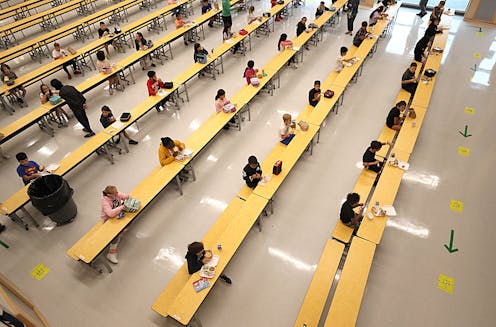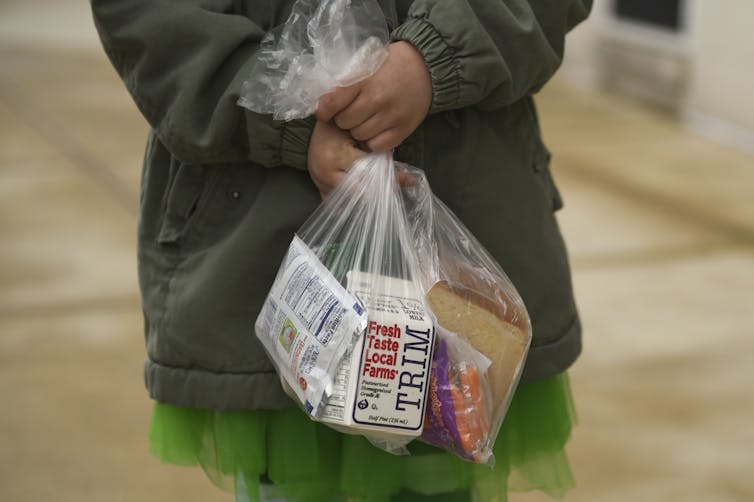How school lunch could improve when classrooms are full again
Students are spreading out when they eat and using more single-serve packaging. Future changes to school meals could be less visible.

The COVID-19 pandemic has completely upended school lunches, like just about everything else for students. Once schools turned into virtual learning platforms, they found creative ways to feed students, including distributing meals at outdoor pickup locations.
Meanwhile, the pandemic has renewed and strengthened national and state-level calls to make school meals free for all students.
The Conversation U.S. asked four school nutrition experts what the break from daily in-person learning may change about school lunch.
1. Cafeterias with more space, less noise
Christine Caruso, Assistant Professor of Public Health, University of Saint Joseph: Even prior to the pandemic, staff and students were concerned about crowding and noise levels in cafeterias, according to research my colleague and I conducted on school meal programs.
Now it’s clear that crowding and loud talking are also serious COVID-19 risk factors.
As more children return to in-person learning, many school districts are letting students eat in their classrooms. Schools are also relying on courtyards or outdoor tents to create safer eating environments.
These measures are critical because the coronavirus spreads through airborne droplets and aerosols.
As a public health precaution, I believe that most schools need to redesign their cafeterias to provide more and varied spaces for students to spread out, rather than being tightly packed together, and muffle noise. In addition to using outdoor spaces and classrooms, students can also eat in hallways and other spaces as needed.
2. Fewer families paying for meals
Michael Long, Assistant Professor of Prevention and Community Health, George Washington University: Serving the 30 million students who rely on school meals has required radical rule waivers and program changes during the COVID-19 pandemic. These changes include adjusting meal requirements and allowing schools to provide free meals to all students.
In my research team’s analysis of government data collected during the 2014-2015 school year regarding costs and nutrition, medium and large schools that offered everyone free lunch and other meals spent US$0.67 less per meal than similar-sized schools that certified students for free and reduced price lunch eligibility based on household income. Despite the lower costs – likely due to administrative savings – nutritional quality remained the same.
The pandemic has renewed and strengthened national and state-level calls to make school meals free across the board.
However, this shift will not be possible without new rules and increased federal funding. Without it, when the COVID-19 waivers expire – currently scheduled for the fall of 2021 – many schools will return to the familiar experience of inadequate funding, big administrative burdens and lower participation rates.
3. Healthier, tastier meals
Caree Cotwright, Assistant Professor of Foods and Nutrition, University of Georgia: Since the pandemic began, schools have modified their lunches in numerous ways, introducing new delivery methods and meal packages to deter the spread of the coronavirus.
Schools need more federal funding and support to continue providing healthy meals to students to reduce health disparities. School lunch is more widely consumed by kids from low-income families and communities of color than their counterparts.
When students return to school, many are eating lunch in their classroom or outside rather than in the cafeteria. In my assessment, eating in a learning atmosphere offers a unique opportunity to bolster nutrition education programs and encourage students to taste new entrees that may be packaged in unfamiliar ways.
For example, one school nutrition director in the Atlanta area described to me a program using online taste tests to make school lunches more appealing to students. To start, parents pick up a week’s worth of school meals, which can be quickly heated and served. Then, a group of students participate in a live Zoom session with a school chef who guides them through warming and assembling a simple school lunch meal, such as cheesy chicken tacos with salsa. Students taste and rate the recipe with the chef. Finally, the video, student comments and taste-test results are posted for other students to view before the recipe is added to the menu.
My research has shown that making school meals more nutritious and delicious requires engaging school nutrition directors, teachers, parents and students. These partnerships can encourage students to try new recipes and better understand how food and the environment are linked – which may result in less food waste.

4. More food justice efforts
Jennifer Gaddis, Assistant Professor of Civil Society & Community Studies, University of Wisconsin-Madison: Congress provided limited funding in March 2020 to help reimburse school food providers for the financial losses they experienced during school closures. But it wasn’t enough.
More than a quarter of districts surveyed by the School Nutrition Association, a nonprofit trade group, said they had cut hours for school cafeteria workers during the pandemic in order to cut costs.
These workers – mostly women and people of color – are far more likely to be in part-time, low-wage jobs and far less likely to belong to unions than the teachers they work alongside.
Before the pandemic, a growing number of schools were employing cafeteria staff to cook nutritious meals from scratch, and implementing farm-to-school programs and other practices to improve jobs, local economies and the environment.
Due to fewer kids eating school meals during the pandemic and the increased costs associated with COVID-19 safety protocols, these positive changes may stall, or even be reversed.
My research suggests these reforms are needed to transform the school lunch experience and maximize the ability of school meals to improve public health and contribute to a post-pandemic economic recovery.
[Deep knowledge, daily. Sign up for The Conversation’s newsletter.]
Jennifer Gaddis is affiliated with the National Farm to School Network as an advisory board member.
Christine C. Caruso is affiliated with the Hartford Food System and Hartford Decide$ as a board member.
Michael Long received funding from the Robert Wood Johnson Foundation to conduct research on school meal costs.
Caree J. Cotwright does not work for, consult, own shares in or receive funding from any company or organization that would benefit from this article, and has disclosed no relevant affiliations beyond their academic appointment.
Read These Next
How to reduce gift-giving stress with your kids – a child psychologist’s tips for making magic and a
Depending on family circumstances and a child’s personality type, gift giving runs the gamut of fun…
The world risks forgetting one of humanity’s greatest triumphs as polio nears global eradication − 7
Polio may finally be defeated in the next 5 years. Will the world recognize what an extraordinary achievement…
Medieval peasants probably enjoyed their holiday festivities more than you do
The Middle Ages weren’t as dreary and desperate as you’d think, and peasants often had weeks of…





